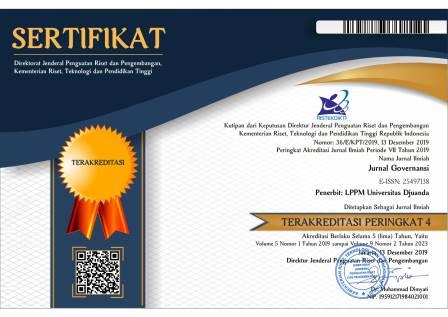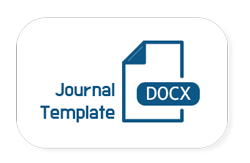PENGARUH KINERJA PEGAWAI TERHADAP PENYELENGGARAAN DIKLAT DI PUSAT PELATIHAN MANAJEMEN DAN KEPEMIMPINAN PERTANIAN (PPMKP) CIAWI BOGOR
DOI:
https://doi.org/10.30997/jgs.v2i1.203Abstract
This research is focused on the impact of employee’s performace against the training administration held by The Management and Leadership Training Center for Agriculture (PPMKP) Ciawi, Bogor, because based on the observation on the field, employee’s performance and training implementation are not yet optimized. The purposes of this study are: (1) To know the employees of PPMKP’s performance, (2) To know how the PPMKP administered the training, (3) To assess if there is any impact on employee’s performance against the training held by PPMKP. The type of research used is quantitative research with associative and descriptive methods. Purposive Sampling is the technique used involving 68 PPMKP employees as sample. The data gathering used was the study of literature and the study of field. To find out the employee’s performances and training administration, analyses descriptive is applied with the result of 4,37 for performance which is in very good category with the lowest value is derived from the indicator expertise in completing the task. Whereas administration of training’s result score of 4,39 which is in very good categoty with the lowest score is derived from the curriculum indicator. To determine the impact on the employee’s performance of training administration the spearman rank correlation is used, with a correlation coefficient of 0,037 and a significance value of 0,766 with positive direction and not significant, meaning thet there is a very low impact on the performance by having training. The conclusion of the research shows that, (1) employee’s performance has been very good with the lowest score is in in the indicator of realibility in completing task, (2) training administration has been very good with the lowest score is in the indicator of curriculum, also (3) there is very low impact on employee’s performance against the trining administration. The possible suggestions made are: first, the expertise of emloyees in completing the task enhanced by giving trainings and study permits for their employees; second, curriculum plan is expected to be more adjustable with the participants by learning more on the participants background; third, research is carried out on other factors that influence the training administration, in order to see the effect on the level of training.
Key words: performance, training administration.
References
Rineka Cipta.
Ambar T Sulistiyani & Rosidah. (2009). Manajemen Sumber Daya Manusia:
Konsep, Teori, dan Pengembangan dalam Konteks Organisasi Publik. Yogyakarta: Graha Ilmu.
Anwar Prabu Mangkunegara. (2004). Manajemen Sumber daya manusia
Perusahaan. Bandung: PT Remaja Rosda karya.
--------------------------------. (2010). Evaluasi Kinerja SDM. Bandung: PT
Refika Aditama.
Guritno, Bambang dan Waridin. (2005). Pengaruh Persepsi Karyawan Mengenai Perilaku Kepemimpinan, Kepuasan Kerja Dan Motivasi Terhadap Kinerja. JRBI. Vol 1. No 1. Hal: 63-74.
Mahmudi. (2015). Manajemen Kinerja Sektor Publik, Yogyakarta: UPP STIM
YKPN.
Moh As’ad. (2003). Psikologi Industri. Yogyakarta: Libery.
Sulistiyani, Ambar T. dan Rosidah. (2003). Manajemen Sumber Daya Manusia. Yogyakarta: Graha Ilmu
Moh. Pabundu Tika. (2010). Budaya Organisasi dan Peningkatan Kinerja
Perusahaan. Jakarta: PT Bumi Aksara.
Mohamad Mahsun. (2006). Pengukuran Kinerja Sektor Publik. Yogyakarta:
BPFE Yogyakarta.
Rivai, Veithzal dan Basri. (2005). Performance Appraisal: Sistem Yang
Tepat Untuk Menilai Kinerja Karyawan Dan Meningkatkan Daya Saing Perusahaan. Jakarta: Rajagrafindo Persada.
Sedarmayanti. (2009). Sumber Daya Manusia dan Produktivitas Kerja.
Bandung: Mandar Maju.
Simamora, Henry, 1997. Manajemen Sumber Daya Manusia. Edisi Kedua.STIE : YKPN
Sjafri Mangkuprawira. (2011). Manajemen Sumber Daya Manusia Strategik. Jakarta: Ghalia Indonesia
Soekidjo Notoatmodjo. (2003). Pengembangan Sumber Daya Manusia. Jakarta: PT. Ranika Cipta.
Sugiyono. (2011). Metode Penelitian Kuantitatif Kualitatif dan R&D, Bandung: CV Alfabeta.
----------- (2012). Metode Penelitian Administrasi, Bandung: CV Alfabeta.
Suharsimi Arikunto. (2006). Prosedur Penelitian. Jakarta: PT. Rineka Cipta
Susilo Martoyo. (2004). Sumber Daya Manusia. Yogyakarta: BPFE.
Tika, P. (2006). Budaya Organisasi Dan Peningkatan Kinerja Perusahaan.
Jakarta: PT Bumi Aksara.
Wursanto. (1989). Manajemen Kepegawaian 1. Yogyakarta: Kanisius.
www.ppmkp.bppsdmp.deptan.go.id
Published
How to Cite
Issue
Section
License
Authors who publish with Jurnal Governansi agree to the following terms:
- Authors retain copyright and grant the journal right of first publication with the work simultaneously licensed under a Creative Commons Attribution 4.0 International License that allows others to share the work with an acknowledgement of the work's authorship and initial publication in Jurnal Governansi.
- Authors are able to enter into separate, additional contractual arrangements for the non-exclusive distribution of the journal's published version of the work (e.g., post it to an institutional repository or publish it in a book), with an acknowledgement of its initial publication in Jurnal Governansi.
- Authors are permitted and encouraged to post their work online (e.g., in institutional repositories or on their website) prior to and during the submission process, as it can lead to productive exchanges, as well as earlier and greater citation of published work.



















